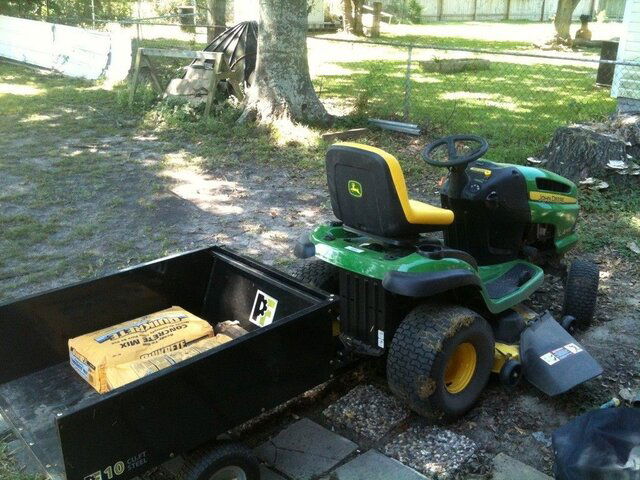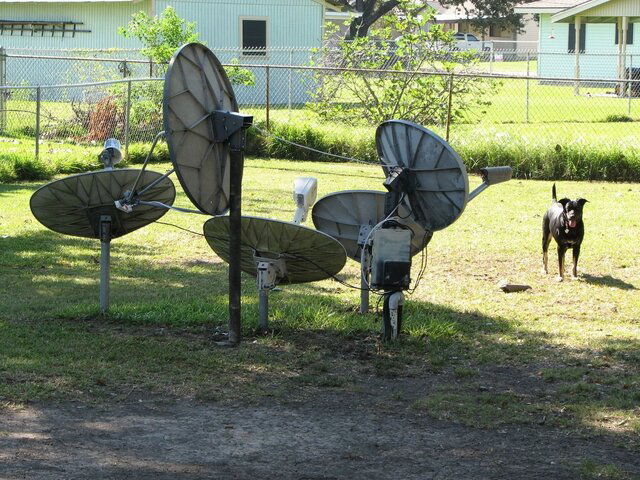also if there is 15.5 volts coming out of the box instead of 18, it sounds like either there is voltage drop across the cable, or the power supply is not outputting the proper voltage a voltage check right at the receiver would be better.
To the other post, you only need to guy the feed if there is end play or if the weight of the feedhorn is causing the button hook to sag.
Some older dishes made the buttonhook to support the weight of a cband only feed, and may not support the weight of a c-ku set up.
A simple way to check this is to get a wooden dowel rod, and center it in the dish or the center of the feedhorn, and make sure that it lines up with the center of the dish or feedhorn. If there is sag, guying the feed horn from the top will take it out. The dowel rod will also come in handy for making sure you have guyed the feed horn center.
Then there is endplay; some button hooks were rather flimsy and the weight of a c-ku setup can cause some swaying in the wind. If you push on feedhorn, and it sways easily, you will need to guy the feedhorn. You will only need to do this on 2 sides, one to stop the feed horn from moving side to side, and one from moving up and down. You will just need to tighten the guy wires enough so that there isn't any excessive play. A eight of an inch or so wont hurt. If you over tighten the guy wires, you will take the feed horn off center and it wont work as good.
BE SURE to use stainless steel or aluminum wire on this, if you use bare steel, it will rust and look bad, and leave rust lines on the feed horn and the rim of the dish.
Do not use the mesh to guy the feed horn, some people will just strand it through the mesh and the outer rib. If there are screws near the end of the mesh, take one of those out, and make a small loop with the wire, and thread the screw through the wire loop, use a washer if needed. Also if there are not any screws you can drill a small hole through the rib, and use a screw or a bolt and nut, do not drill a hole any bigger then the size of a pencil or you will weaken the structural integrity of the outer rib. On solid dishes, just drill a small hole about a half and inch away from the edge.
To the other post, you only need to guy the feed if there is end play or if the weight of the feedhorn is causing the button hook to sag.
Some older dishes made the buttonhook to support the weight of a cband only feed, and may not support the weight of a c-ku set up.
A simple way to check this is to get a wooden dowel rod, and center it in the dish or the center of the feedhorn, and make sure that it lines up with the center of the dish or feedhorn. If there is sag, guying the feed horn from the top will take it out. The dowel rod will also come in handy for making sure you have guyed the feed horn center.
Then there is endplay; some button hooks were rather flimsy and the weight of a c-ku setup can cause some swaying in the wind. If you push on feedhorn, and it sways easily, you will need to guy the feedhorn. You will only need to do this on 2 sides, one to stop the feed horn from moving side to side, and one from moving up and down. You will just need to tighten the guy wires enough so that there isn't any excessive play. A eight of an inch or so wont hurt. If you over tighten the guy wires, you will take the feed horn off center and it wont work as good.
BE SURE to use stainless steel or aluminum wire on this, if you use bare steel, it will rust and look bad, and leave rust lines on the feed horn and the rim of the dish.
Do not use the mesh to guy the feed horn, some people will just strand it through the mesh and the outer rib. If there are screws near the end of the mesh, take one of those out, and make a small loop with the wire, and thread the screw through the wire loop, use a washer if needed. Also if there are not any screws you can drill a small hole through the rib, and use a screw or a bolt and nut, do not drill a hole any bigger then the size of a pencil or you will weaken the structural integrity of the outer rib. On solid dishes, just drill a small hole about a half and inch away from the edge.





 : <--- homework....
: <--- homework....
